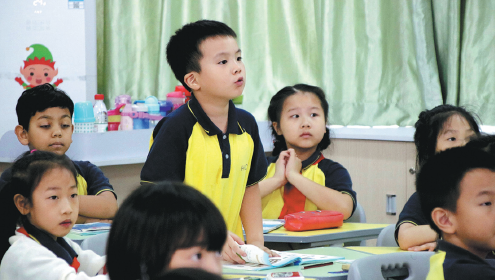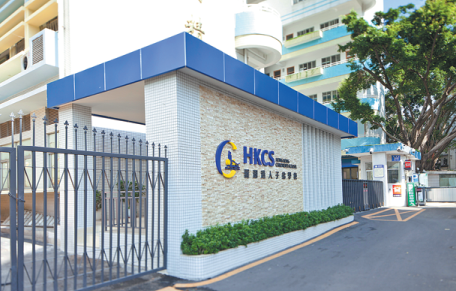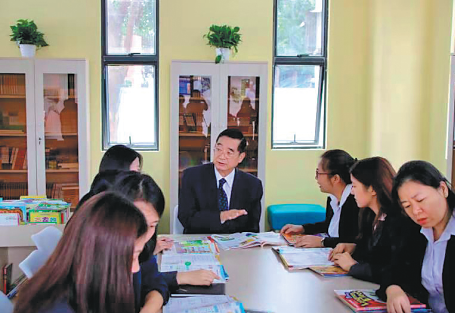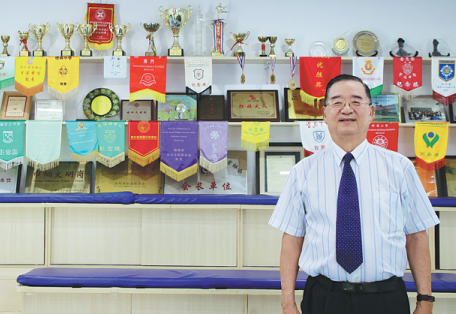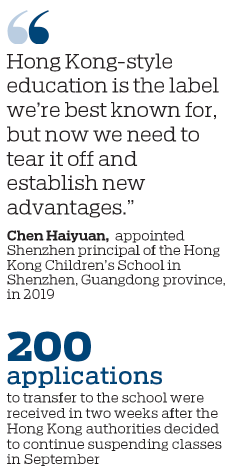INNOVATIVE SCHOOL FINDS THE RIGHT MIX
Shenzhen institution showcases cross-border integration
Liu Cheung-hin, headmaster of a Hong Kong primary school, was preparing to retire from teaching in 1999 when he suddenly changed his mind.
He was 56 at the time and had only a year to go before calling it a day, when he decided to take a new job in Shenzhen, Guangdong province, across the border with the Chinese mainland.
This decision put any thoughts he had of retiring on hold for two decades.
Liu was tasked with taking charge of a newly established private school designated for children from Hong Kong.
Situated in Luohu district, the Hong Kong Children's School, the first to be established in Shenzhen specifically for Hong Kong children, was founded in 2001.
It was designed to meet the growing need for a Hong Kong-style primary school as more people from across the border sought business or employment opportunities in Shenzhen, home to the nation's first special economic zone.
Now, 20 years later, the school is facing the biggest challenge since it was founded-a rapidly dwindling pool of students.
Liu accepted an offer to be the school's principal to "keep himself busy", offering his services for free.
He was mainly responsible for liaising with the Hong Kong authorities and parents from the city whose children attend the school. Another principal from Shenzhen dealt with other matters.
Liu commuted between Hong Kong and Shenzhen several times a month. He offered advice on managing daily operations at the school, liaised with the Hong Kong authorities on securing high school places in the city for students graduating from the establishment, and organized exchanges between teachers from both sides.
He was among the first group of Hong Kong educators to arrive in Shenzhen. However, he encountered a number of problems at the school, including its overall aims and ways in which to teach Hong Kong-style lessons.
It was difficult to recruit Hong Kong teachers for the school, as they needed mainland qualifications. Problems were compounded by the wide salary gap between the two cities. As a result, most of the teachers had to be recruited from the mainland.
With the school unable to hire Hong Kong teachers to work across the border, Liu decided to bring mainland teachers to Hong Kong for them to gain more experience.
He also told Hong Kong teachers to attend training sessions in Shenzhen.
Cao Li, who heads a team of English-language teachers at the school, said she has benefited from its pioneering teaching methods. She comes from Heilongjiang province and has been with the school for 12 years.
Upon joining the institution after graduating from university, she had to teach students with English-language textbooks used in Hong Kong, which she said are more difficult and complex than those used on the mainland. She added that this was a "real challenge".
However, the situation improved after three experienced English-language teachers from Hong Kong joined Cao and her colleagues for two weeks in Shenzhen. During their visit, she learned useful ways to help students at the school.
In the following years, Cao visited Hong Kong schools five times, learning new teaching methods on each occasion.
Given these opportunities and a "conducive atmosphere" at the school, Cao believes she has the ideal platform to improve herself. She said the school is not inferior to public educational facilities popular among mainland teachers.
Liu, in addition to adopting Hong Kong teaching methods on the mainland, stood at the school gate to shake hands with each student after classes to let them and their parents feel they were respected and cared for.
The Luohu school combines the best of the Hong Kong and mainland educational systems to make students more competitive.
English-language and general studies lessons follow standards set for Hong Kong schools, while mainland textbooks and teaching methods take precedence for Chinese-language and mathematics classes.
With its Hong Kong-style education, the school stands out amid fierce competition in Shenzhen. It initially had just 16 students, now has 1,300, but numbers are falling.
Most of the students come from Hong Kong, but there is also a considerable number from the mainland, Macao, Taiwan and overseas.
Zheng Yalin, a Macao student who was among the first group of 16 students to enroll at the school, said her parents chose it because few alternatives were available, adding that it proved to be the right decision.
Everything appeared tough at first and students had to "feel their way", Zheng said.
However, after performing exceptionally well in the graduation examination, she enrolled at Renmin University of China-one of the nation's top higher education institutions-before furthering her studies at New York University.
Zheng attributes the smooth teaching process at the school to its strength in English and the way in which it has blended cultures. The strong foundations it has laid have helped many of her classmates to study or work overseas.
Noting that the school has a strong reputation among Hong Kong and Macao parents, Zheng said it should strengthen promotion work to attract more mainland students.
This suggestion is in line with an idea from Chen Haiyuan, who was appointed the school's new Shenzhen principal in 2019. With Liu gradually relinquishing many of his responsibilities due to age, Chen took over most of the managerial duties.
In 2013, the school's primary source of students was affected after the Hong Kong government banned non-permanent residents from giving birth in the city.
As a result, the number of students at the school from Hong Kong has fallen since last year and is expected to plummet further.
More than 200,000 children whose parents were not Hong Kong identity card holders have been born in the city since 2001-before the ban was introduced-spurring the development of a number of Hong Kong-oriented educational institutions in Shenzhen.
Shenzhen has two schools designated especially for Hong Kong children, including the Luohu facility. The city also has seven others offering classes for such children, along with standard mainland courses for local students.
More scope
Since 2019, the proportion of Hong Kong students among those newly enrolled at the Luohu school has fallen from 80 percent to about 50 percent.
Chen said, "Hong Kong-style education is the label we're best known for, but now we need to tear it off and establish new advantages."
Transferred from a public school in Guangzhou, capital of Guangdong, Chen believes the blending of Hong Kong and mainland education methods at the Shenzhen school offers more scope for innovation.
Aiming to be a game-changer, he has reformed the school's curriculum, teaching style and management.
Amid an evolving student population, Chen has streamlined content for general studies-one of the four key subjects in Hong Kong primary school education, along with Chinese, English and mathematics.
The school has introduced courses such as Education of International Understanding, and also Robotics, to widen students' perspective and encourage their interest in science.
More efforts have been made to develop self-learning ability among its senior students. Rather than simply following teachers, these students are often required to summarize the content of textbooks before presenting the results to classmates.
Chen has also updated the appraisal system for teachers, offering more incentives for members of staff who perform well.
He hopes the measures he has introduced will encourage more initiative from teachers and students, and inject new momentum for the school to advance amid challenges such as those posed by the pandemic.
To address such challenges, Chen is eyeing new opportunities through closer cross-border interaction as part of the plan for the Guangdong-Hong Kong-Macao Greater Bay Area.
After social unrest in Hong Kong in 2019, and amid the pandemic, a group of Hong Kong children living in Shenzhen but studying in their home city have switched back to attending schools in Shenzhen.
In September, the Luohu school received some 200 transfer applications in two weeks after Hong Kong decided to continue suspending classes, but could only offer about 20 places, Chen said.
He envisions that in the long run, incentives will continue to be introduced to attract talent from Hong Kong to the mainland, with the aim of building the 11-city Greater Bay Area into a world-class technological powerhouse. This would also result in a rise in the number of Hong Kong children based in Shenzhen.
In view of the Greater Bay Area's prospects, many Hong Kong parents have said they are willing to allow their children to continue studying on the mainland, Chen said.
The Hong Kong Education Bureau has voiced support for schools in the Greater Bay Area offering 12 years of education to Hong Kong and Macao students.
Some secondary schools in Guangzhou have classes designated for students from Hong Kong and Macao, but in Shenzhen, all schools and classes catering to such students only offer education at primary level.
With central government support, and to address long-term demand, the Luohu establishment has proposed setting up a secondary school for Hong Kong children in Shenzhen. Discussions have started on details of the plan, including the location and the curriculum.
Liu, now 77, has done what he set out to accomplish, in line with a saying by Confucius, "It doesn't matter how slowly you go as long as you do not stop."
Now living in Shunde, Guangdong, a city known for its Cantonese cuisine, Liu has taken up a wide range of activities in "retirement".
Besides leading the Luohu school, he also has another role to challenge himself-training teachers in areas such as Guizhou province, Guangxi Zhuang autonomous region and Xinjiang Uygur autonomous region.
Speaking about the school's development, he said the "unique bonds "between Shenzhen and Hong Kong enabled the facility and himself to undertake a series of missions.
By resolving firmly to serve the young people of Hong Kong and Shenzhen, the school, which is marking its 20th anniversary, appears to have established a path for itself.
bingcun@chinadailyhk.com
